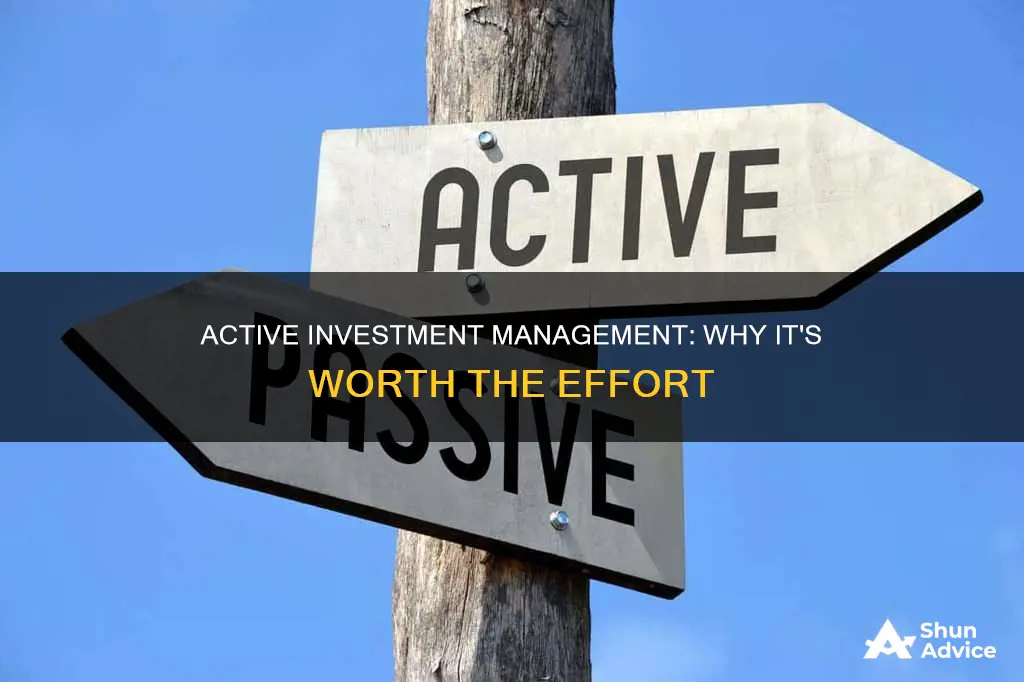
Active investment management is an approach to investing where the investor or a dedicated professional selects the investments that make up their portfolio. Active investors aim to generate additional returns by buying and selling investments advantageously, seeking to profit from market inefficiencies by purchasing investments that are undervalued or selling securities that are overvalued. Active investors use various techniques to identify mispriced investments, including fundamental analysis and quantitative analysis. Active management is often compared to passive management or index investing, which follows simple rules that try to track an index or other benchmarks by replicating it. Active management provides investors with the potential for higher returns and is more flexible than passive management, allowing investors to tailor the risk of their investments to match their risk tolerance.
What You'll Learn

Exploiting market inefficiencies
Market inefficiencies can occur due to information asymmetries, transaction costs, market psychology, and human emotion. For example, small-cap stocks may not be as widely held or closely followed as large-cap stocks, leading to delays in news, whether good or bad, being reflected in the stock price. This creates an opportunity for active investors to purchase these stocks at a bargain price before the market fully digests the new information.
Active investment managers can exploit these inefficiencies by conducting extensive research and analysis, using their expertise and judgement to identify undervalued stocks or assets. They can then adjust their clients' portfolios to take advantage of these opportunities and meet specific needs such as providing diversification or targeted investment returns.
For instance, Sam Berridge, Portfolio Manager at Perennial Value Management, launched the Perennial Global Resources Trust, a mining fund, during the COVID-19 crisis. Berridge's expertise as a geologist, analyst, and investment professional allowed him to identify opportunities in the commodity space, which had been "unloved" for a long time and was experiencing a decline in investment expertise. By visiting mine sites, speaking to contractors and service providers, and staying up-to-date with expansion plans and emerging mining tech, Berridge was able to exploit market inefficiencies and achieve fantastic performance.
However, it is important to note that active investment management does not always guarantee higher returns. Studies have shown that active investment managers often struggle to pick enough winners to justify their high fees, and it can be challenging to consistently beat the market. As such, passive investments, which aim to duplicate market returns, may be a more suitable strategy for the bulk of an investor's holdings.
Why You're Not Saving and Investing: Excuses Debunked
You may want to see also

Niche market advantages
Active investment management is a strategy that involves ongoing buying and selling activity by the investor. Active investors continuously monitor their investments to take advantage of profitable conditions and seek short-term profits.
Active managers thrive in niche markets where flexibility and knowledge are more important than size. In these markets, active managers can leverage their expertise to identify undervalued investments and generate higher returns for their clients.
For example, in emerging markets, information can be harder to find, and companies may be less well-researched. Active managers with specialized knowledge in these markets can exploit this information asymmetry to find the best investment opportunities.
A 2017 study of 126 emerging market funds found that active managers delivered returns of 31.8% after fees over a ten-year period, significantly outperforming the 7.7% return of a passive alternative.
Another niche market where active managers can have an advantage is in smaller companies. Smaller companies may be attractively valued and exhibit strong growth potential, yet they are often omitted from indices that are biased towards large-cap stocks. Active managers can identify these overlooked opportunities and include them in their portfolios.
Additionally, active managers have the flexibility to invest in frontier markets and preference shares, which are typically excluded from indices but often offer the greatest rewards.
The ability to navigate and exploit these niche markets provides active managers with a distinct advantage over passive investment strategies, allowing them to generate superior returns for their clients.
Assessing Investment Portfolios: A Comprehensive Guide
You may want to see also

Better resource allocation
Active investment management is a strategy that involves ongoing buying and selling activity by the investor. Active investors seek to profit from market inefficiencies by purchasing investments that are undervalued or by selling securities that are overvalued. Active investment management can lead to better resource allocation in the following ways:
Firstly, active investment management allows investors to allocate resources to specific companies or sectors that they believe are undervalued or have high growth potential. By conducting in-depth research and analysis, active managers can identify companies with strong fundamentals, favourable market trends, and positive economic indicators. This enables them to make informed decisions about allocating resources to these companies, potentially resulting in higher returns.
Secondly, active investment management provides flexibility in investment choices. Unlike passive investment, which primarily focuses on replicating a specific market index, active management allows investors to allocate resources across a diverse range of asset classes, including stocks, bonds, and other investment vehicles. This flexibility enables investors to adjust their portfolios based on their risk tolerance, income generation goals, and market conditions.
Thirdly, active investment management facilitates better resource allocation by enabling investors to align their investments with their specific goals and values. For example, investors may choose to allocate resources to companies that demonstrate a commitment to environmental, social, and governance (ESG) standards or that align with their personal values and mission-based objectives. This allows investors to have a positive impact on society and the environment while also potentially generating financial returns.
Additionally, active investment management provides the advantage of risk management. Active managers can dynamically adjust their portfolios to reduce exposure to high-risk assets and seek safer investments. By utilising various risk-assessment tools and metrics, they can gauge overall risks, such as equity market risk, interest rate risk, credit risk, and liquidity risk. This proactive approach to risk management helps protect investors' capital and provides a more stable foundation for resource allocation.
Lastly, active investment management allows for tactical asset allocation, particularly in managed solutions. By constantly monitoring market trends, sector performance, and various indicators, active managers can make real-time adjustments to their portfolios. This dynamic approach enables them to capture short-term opportunities and protect investors' capital against risks, resulting in better resource allocation decisions.
529 Savings Plans: Smart Investment Strategies, per Forbes
You may want to see also

Risk management
Active investment management enables investors to adjust their portfolios in real time as market conditions change. This is particularly important during times of market volatility or crisis, such as the 2008 financial crisis, when investment managers can reduce their clients' exposure to risky sectors or assets. Active managers can also use various hedging strategies, such as short selling and derivatives, to further mitigate risk.
Additionally, active managers can tailor the risk of their investments to match their clients' risk tolerance levels. For example, more conservative investors may want to adjust their portfolios to focus on blue-chip investments, or they may plan to adjust their risk exposure as their personal circumstances change. Active managers can also help clients limit their exposure to certain sectors or industries, such as employees of high-tech companies wanting to reduce their investment in tech stocks.
Active management also allows for better tax management, which can be tailored to individual investors' needs. For example, selling money-losing investments can offset taxes on winning investments.
Furthermore, active managers can proactively identify, assess, and mitigate potential risks in a portfolio. They use various risk-assessment tools and metrics to gauge overall risks, including equity market risk, interest rate risk, credit risk, and liquidity risk. By doing so, they can reduce exposure to high-risk assets and seek safer investments to protect their clients' capital.
However, it is important to note that active management does not guarantee superior risk management compared to passive management. Passive investment strategies can also provide risk management benefits by diversifying investments across a wide range of assets and reducing the impact of individual stock or sector volatility.
Becoming an ERISA 3(38) Investment Manager: A Comprehensive Guide
You may want to see also

Higher returns
Active investment management is a strategy that aims to beat the market and generate higher returns than passive investment strategies. The goal of any investment manager employing this strategy is to outperform a designated benchmark, such as a market index, while also achieving other goals such as managing risk, increasing income, or adhering to specific standards like ESG (environmental, social, and governance) criteria.
Active investment managers employ various techniques to achieve higher returns. They actively monitor and analyse investments, making buy, hold, and sell decisions based on their expertise and judgement. This involves a deep analysis of investments, including price changes, returns, and company financial statements. Active managers can also use quantitative tools and algorithms to identify stocks that are undervalued or have the potential for strong performance. This flexibility allows them to identify "diamonds in the rough" and adjust their portfolios to take advantage of short-term opportunities.
Additionally, active investment managers can employ hedging strategies such as short selling and using derivatives to manage risk and protect their portfolios from significant losses. They have the ability to exit specific stocks or sectors when risks become too large, providing better risk management compared to passive strategies. This was evident during the 2008 financial crisis, where active managers could have reduced their clients' exposure to the financial sector.
While active investment management aims for higher returns, it is important to consider the associated costs. Actively managed funds generally have higher fees due to the extensive research and analysis required, as well as the potential for numerous transactions. These fees can impact overall investment returns, and investors should carefully evaluate the actual returns after fees.
Microservices in Investment Portfolio Management: Strategies and Benefits
You may want to see also







